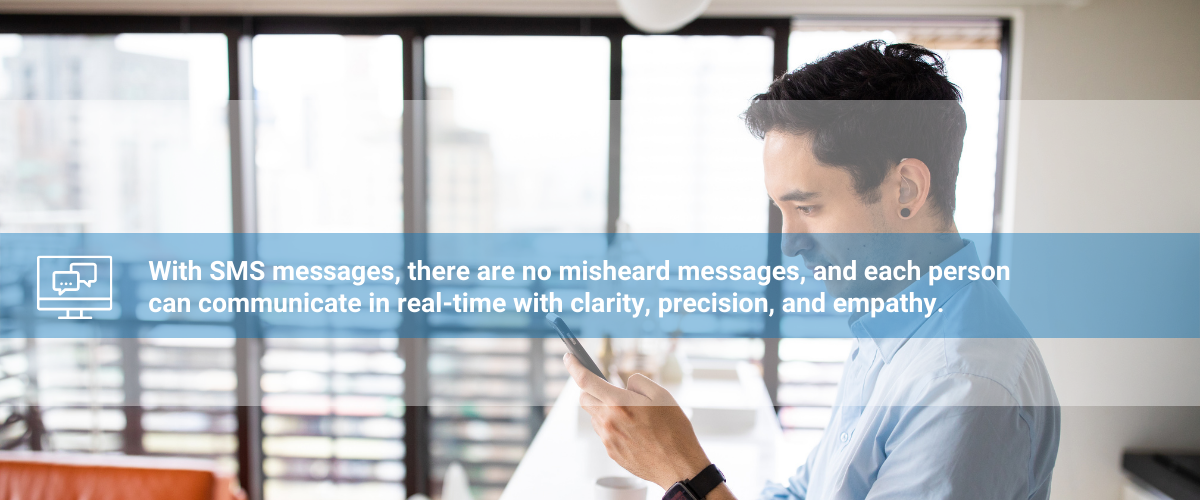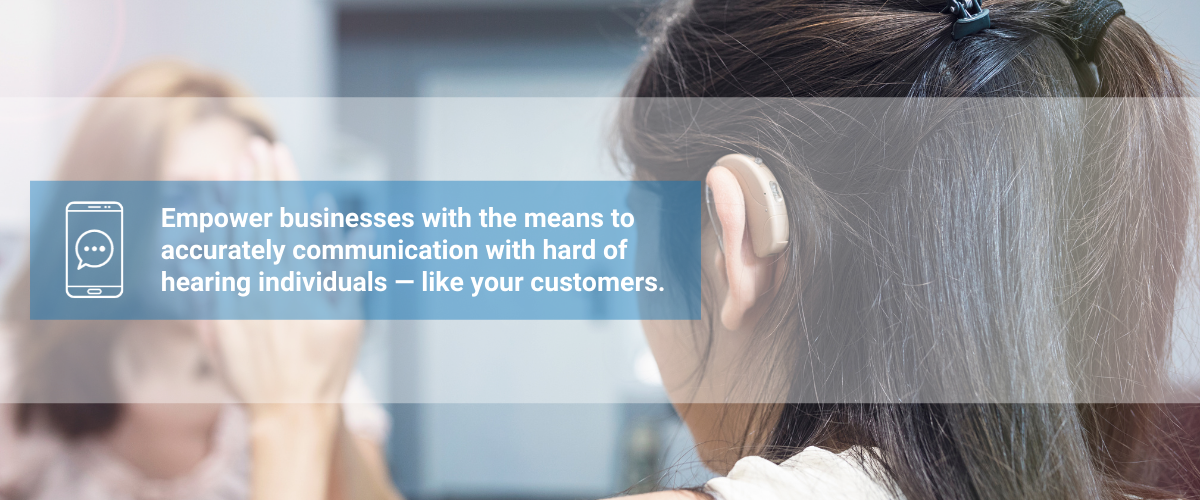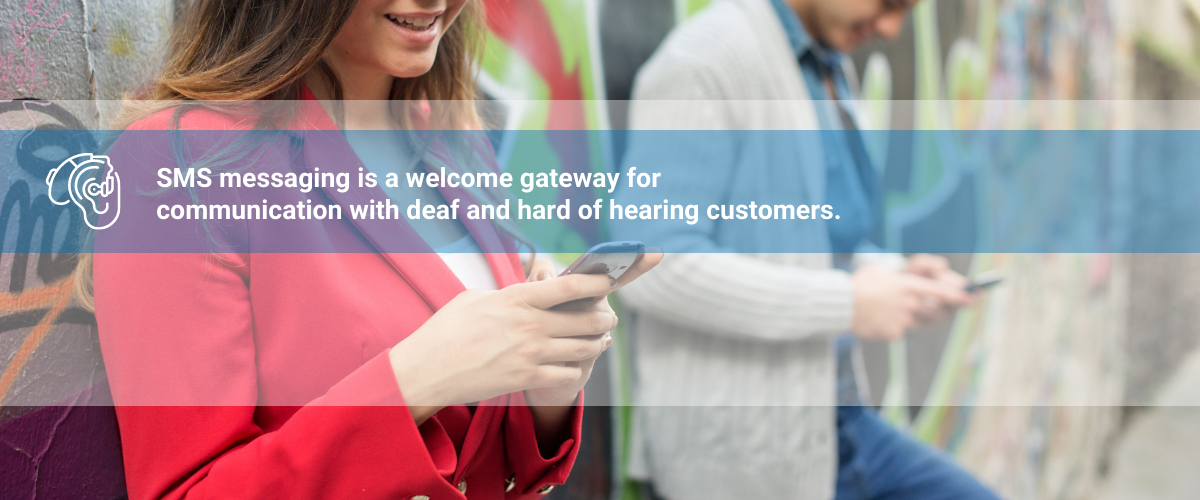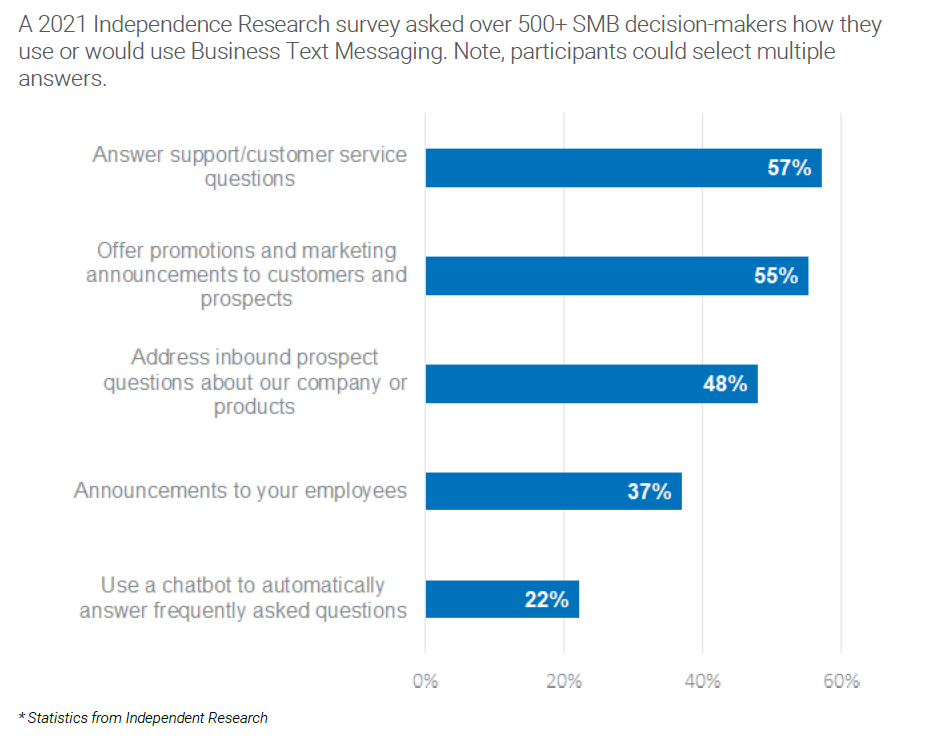Current Environment for the Hearing Impaired
Many companies aren’t equipped to help customers who are deaf, hard of hearing, or have a speech impediment. For people with hearing or speech difficulties, a last-minute change to an appointment or picking up the phone to make a call isn’t always feasible.
While there are multiple text-based communication channels available, the most common tools like Facebook Messenger and WhatsApp are intended for personal use, not business use.
There are risks for businesses that elect to use personal communication tools for business purposes, including:
• The potential transmission and distribution of private or sensitive company data.
• Apps often collect personal user data, which may clash with corporate privacy policies.
• Restricts the company’s control and visibility over the conversation, therefore hampering their support of end users.
• Prevents the organization from being able to investigate electronic communication Code of Conduct complaints or concerns.
Issues with Traditional Communication Channels
Organizations often assume that their consumers will easily be able to interact with them using their existing communication channels, but that isn’t always the case for people with a hearing impairment.
• Phone Calls. Often difficult and frustrating for customer, and important moments are missed.
• Email. Delayed response time and no immediate resolution.
• Website Chat Bots. Limited capacity to respond and assist customers because they are unable to adapt to unique situations, which can create a negative customer experience.
• Telephone Typewriter (TTY). Not agile or mobile and can require external hardware.
• National Relay Service. Time consuming and doesn’t allow for real-time communication due to the translation delay from user to agent to business.
• In-Person. Employees are likely ill equipped to assist, leading to a frustrating experience for everyone.
Think this doesn’t apply to your business? The numbers speak for themselves:
• 1 out of 5 men and 1 out of 8 women (37.5 million adults) report at least some trouble hearing.
• 1 in 8 people in the United States (30 million) aged 12 years or older experience hearing loss in both ears, based on standard hearing examinations.
• About 40 million US adults aged 20–69 years have noise-induced hearing loss.
• Men are almost twice as likely as women to have hearing loss among adults aged 20-69.
• More than 1 in 2 US adults with hearing damage from noise do not have noisy jobs, meaning the exposure is likely recreational.
• 1 in 4 US adults who report excellent to good hearing already have hearing damage.
• 28.8 million US adults could benefit from the use of hearing aids.
Source: National Institute on Deafness and other Communication Disorders, Healthy Hearing Report

Business Text Messaging vs. Traditional Communication
Using a text messaging solution, SMBs can easily resolve customer inquiries, send reminders, promote events, automate common responses, and more — all from the business phone number their customers already know and trust.
• Clear Communication. No miscommunications or missed context.
• Real-Time Communication. No call captioning agents needed, so customers get fast replies and instant service.
• Extend Your Customer Base. Reach more customers with ease. Send texts in any language to engage with multilingual customers.
• Increase Sales. Add calls to action, links to your website, enticing messages, customer satisfaction surveys, and more. SMS messages with rich media links can achieve a 27% click-through rate!
• Reduce Costs. SMS conversations are 8x cheaper for a business than phone calls.
• Increase Effectiveness. SMS is 28x times more effective than email. Increase audiences by 11.4% and response times by 60x.*
• Enhance Branding. Keep messaging consistent with your brand’s voice.
• Reduce Effort & Time. Schedule campaigns and automatically reply to messages based on keyword triggers for frequent customer questions to reduce repetitive message actions and increase employee productivity.
How Do Email vs SMS Compare? See Our Quick ROI Comparison

Business Text Messaging Benefits for the Deaf and Hard of Hearing
Text messaging makes it easy for people who are deaf or hard of hearing to interact a business without needing another device. Consumers already use their smartphones to communicate with friends and family, and most would prefer to communicate with businesses the same way. SMS messages are an inclusive communication channel that lets SMBs effectively interact with their customers, regardless of hearing capacity. All customers get the support they need, saving businesses save time and money. It’s a vital tool for SMBs to drive exceptional customer experiences with their entire customer base.
As a SaaS application, business text messaging doesn’t require end users to download another application or maintain software updates. It’s device agnostic and user friendly for all age ranges, regardless of technological proficiency. Best-in-class SMS and MMS solutions offer an intuitive web app, bulk messaging, customizable response templates, message bots, and more.
SMBs Also Benefit from Business Text Messaging
How will they communicate with customers who can’t hear them?
Many readily available communication tools lack mobility and require a learning curve. Business text messaging solutions are a cloud-based tools with an intuitive admin portal for provisioning customers and managing accounts — some even offer APIs to integrate back-office ordering, billing, and support systems.
The benefits are substantial:
• Text messages have a 98% open rate.
• 78% of Gen Z consider their mobile phone their most important device to get online.
• The average click-through rate for email marketing is 2.5%. In comparison, the SMS marketing click-through rate is around 19%.
• 61% of Gen Z purchased a product via mobile in the last month.
• Consumers who get SMS marketing messages are 40% more likely to convert than those who don’t.
• 90% of SMS messages are read within three minutes.
• 95% of text messages are delivered and read within 3 minutes.
* Statistics from PR News Wire
Business Text Messaging is the ideal solution for any business that seeks to streamline inbound and outbound communications. With limitless applications, service providers can target a wide range of industry verticals to meet SMB needs with ease.
Business Text Messaging Creates Service Provider Opportunities
Many consumers not only prefer text messages to phone calls for short exchanges but also prefer companies that offer text messaging as a communication channel. In fact, almost 63% of consumers would switch to a company that offers it. *SMBs and enterprises are seeking out text message solutions to meet their customers’ expectations, creating a substantial market opportunity for service providers.
By incorporating an SMS solution into an existing solution suite, service providers can improve market differentiation, increase customer stickiness, and expand commercial sales opportunities. As a cloud-based solution, Alianza’s Business Text Messaging can be launched quickly and delivers a profitable business texting solution while allowing providers to maintaining control over pricing, feature bundling, and customer relationships.

Proven Market Interest For Business Text Messaging
A 2021 Independence Research survey asked over 500 small business decision makers how they use or would use business text messaging, and here’s how they responded:

Start Growing Today With Business Text Messaging
Deliver a compelling new communication service to SMB customers with Alianza’s Business Text Messaging. With limitless applications, service providers can target an unparalleled range of industry verticals and be able to meet the needs of individual SMBs with ease.
Sell Business Text Messaging standalone or bundled with your business voice products to drive greater revenue, market footprint, and customer lifetime value (CLV). It can also be sold anywhere — even outside your broadband or voice footprint — and over the top of any voice solution.


